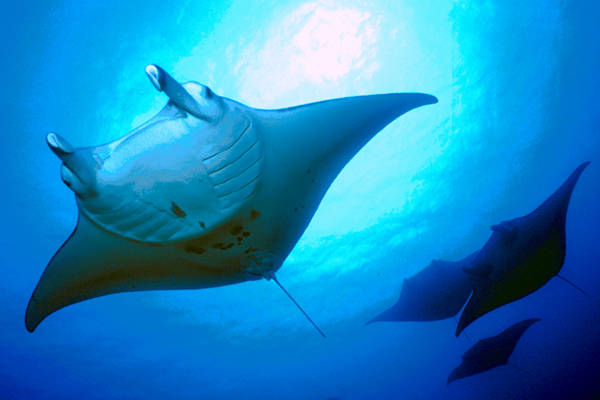Rays to boost nature-based tourism in Indonesia

Indonesia is now the world's largest sanctuary for manta rays, after the Indonesian Government backed evidence supporting the marine giants' tourism value.
Indonesia now plans that manta rays within the archipelago's 5.8 million kilometre2 of ocean will be protected from fishing and export.
However, the Indonesian Government appreciates that it will take time and cooperation at multiple levels to enforce the ban on poaching in the biggest global shark and ray fishery.
Conservationists point to simple economics as an incentive. According to a study published last year in the online PLOS One (Public Library of Science) journal, a manta ray is worth up to US $1 million over the course of its long lifetime, thanks to tourists willing to pay generously for a chance to swim with the curious creatures that glide gracefully through the water by flapping their wide wings, almost as if flying. By contrast, the PLoS One study suggested they have a value of less than US$500 dead.
Welcoming the development, Conservation International Indonesia, Marine Program Director Tiene Gunawan explained that Government officials were "so surprised that the tourism value is very high (which is) a very powerful argument.
"Indonesia is such a big, big, big country. When looking at the size of the water, it's huge. And I think we should start small and make some kind of pilot for this enforcement."
With the regulation passed in late January, conservation groups are working to teach fishermen about the value of keeping the mantas alive, while business people, the military, water police and local officials are being engaged to assist.
At a recent news conference, Indonesia's Director General for Marine, Coastal and Small Islands, Sudirman Saad said the Government will encourage fishermen affected by the ban to take advantage of manta ray tourism, adding "there are more than 200 special policemen who have been prepared to guard conservation areas and to enforce the law on protection of this species,"
Former fishermen on the resort island of Bali are already profiting from taking snorkelers out on their fishing boats, or working at larger dive resorts where mantas are a top attraction.
In Indonesia alone, manta ray tourism brings in an estimated $15 million each year, according to the PLOS One report.
Head of Indonesia's Marine Conservation Directorate, Agus Dermawan stated "Indonesia now has the second-largest manta ray tourism industry in the world.
"Given the huge area of reefs and islands in our country, if managed properly, Indonesia could become the top manta tourism destination on the planet."
Indonesia is home to two types of rays, the manta and the mobula. Both are killed for their plankton-filtering gills, which are used for medicinal concoctions, mainly in China. Mantas are also frequently caught accidentally by fishermen, but they are not part of a major targetted industry in Indonesia as in other countries, such as Sri Lanka
Increased demand has led to a sharp drop in manta numbers in recent years, raising international concern. As a result, in 2013 the Convention on International Trade in Endangered Species (CITES) of Wild Fauna and Flora imposed new trade regulations for the species.
Mary O'Malley, lead author of the PLOS One report from the San Francisco-based nonprofit WildAid, stated "enforcement and community education are always necessary in order for this or any law to have a real impact, but passage of the law is a critical step."
WildAid is currently planning to launch a campaign in China to address demand there.
Mantas are among the world's largest fish and can reach up to 8 metres from wingtip to wingtip. Found in the tropics, they can live up to 50 years, but do not mature until at least eight years and typically give birth to a single pup only every two to five years. This slow reproduction rate means fishing cannot be sustained over the long haul, and mantas are classified as vulnerable to extinction on the International Union for Conservation of Nature's Red List of Threatened Species.
Mantas are capable of migrating more than 1,000 kilometres, and each has a unique pattern of spots on its belly. Unlike stingrays, they have no barbs and are harmless to humans.
Even though they are beloved by divers and snorkelers, due to their size, friendliness and graceful beauty in the water, much remains unknown about their population numbers worldwide.
Early last year, Indonesia's Institute of Science estimated that the country has 17,000 mantra rays, though it said that approximation did not account for regional migrations and may be overly optimistic.
In addition to Indonesia, manta fishing is banned in Australia, Ecuador, the European Union, Mexico, New Zealand, the Philippines, Guam, the Micronesian island of Yap, the Northern Mariana Islands and the US states of Hawaii and Florida.






